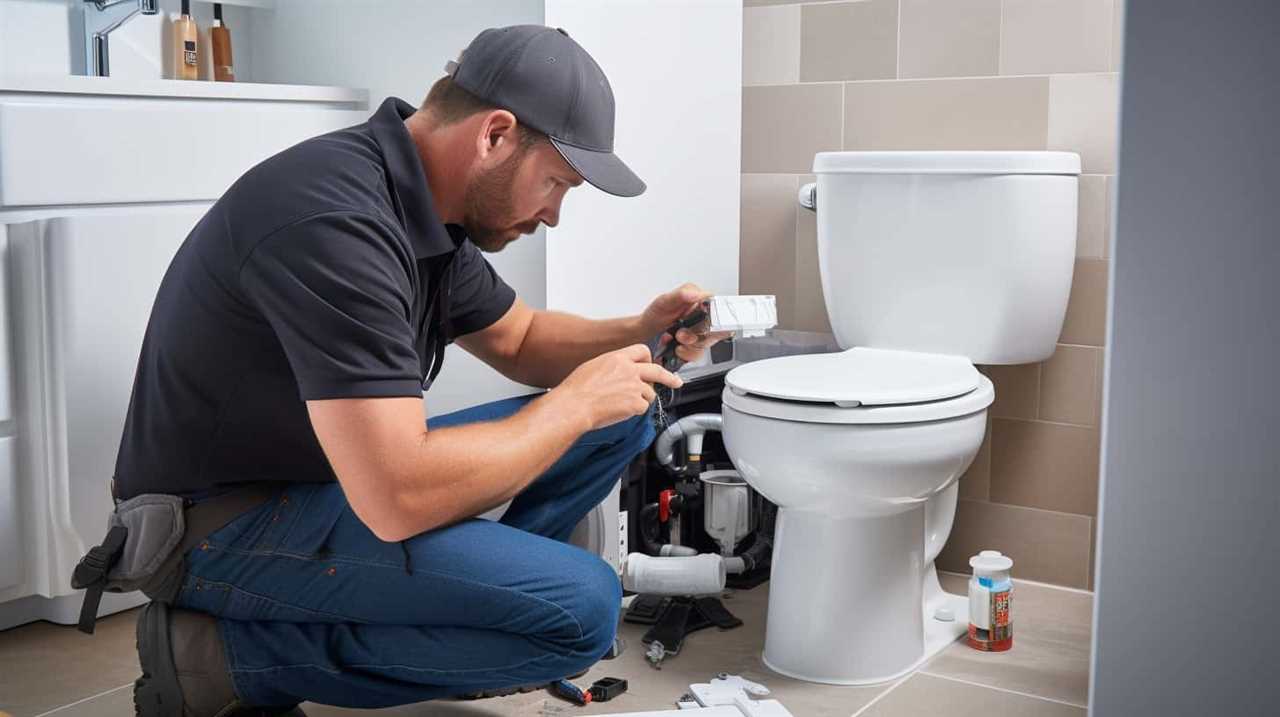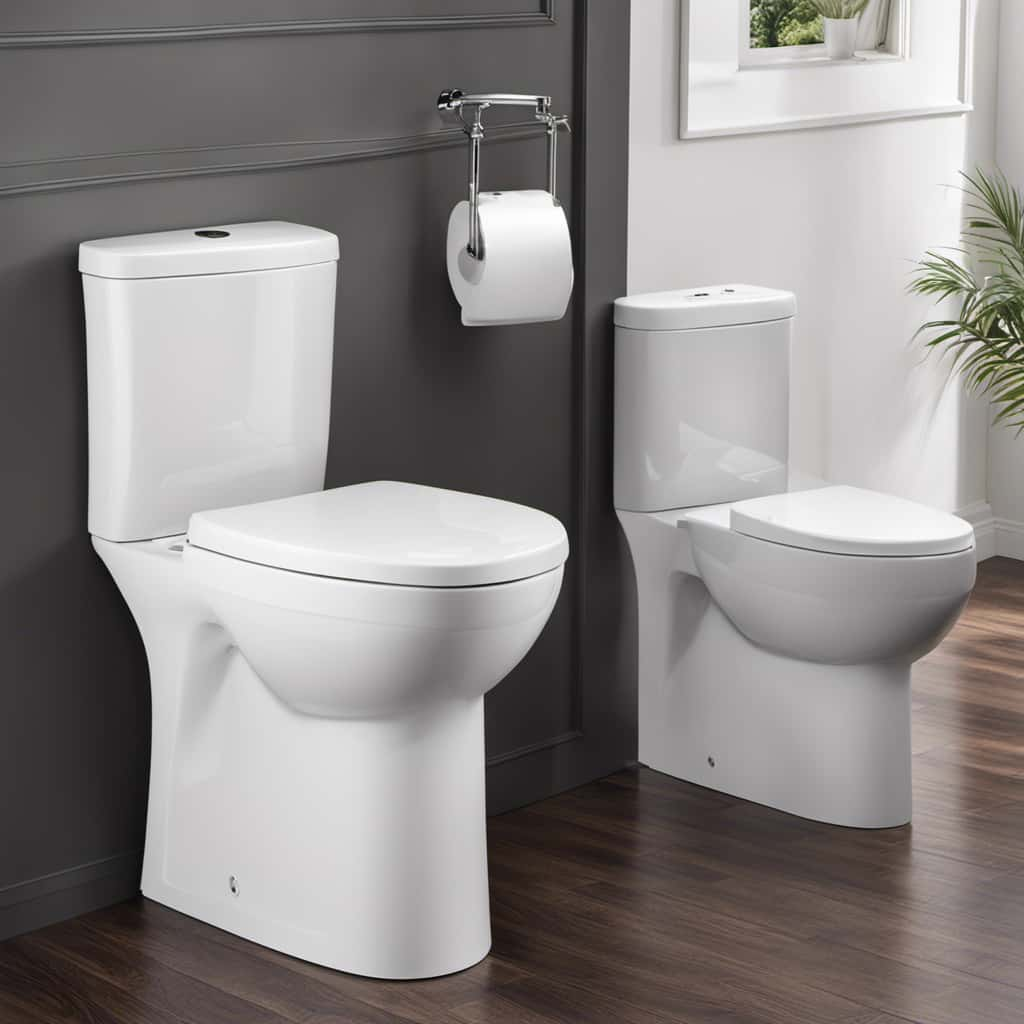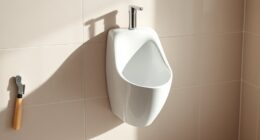Have you ever been surprised by the sudden gush of water in your bathroom? We’ve all faced the annoyance of a toilet that appears to flush on its own.
But fear not, for we are here to guide you through the steps to stop this annoyance once and for all.
In this article, we will share our expertise on how to fix your toilet and restore peace to your bathroom.
So grab your tools and let’s get started!

Key Takeaways
- The flapper valve controls the flow of water from the tank to the bowl and can become worn or damaged over time, causing continuous flushing or water leakage.
- Adjusting the water level using the water level adjustment screw or valve on the fill valve can help regulate the flushing mechanism.
- A faulty fill valve can cause continuous or random flushing, and it may need to be replaced by turning off the water supply, draining the tank, and installing a new fill valve.
- Cleaning the flush mechanism, including the flapper valve and chain, is essential for preventing automatic flushing and can be done by turning off the water supply, removing the tank lid, and cleaning the inside of the tank.
Check the Flapper Valve
To address the issue of a toilet flushing itself, we need to start by checking the flapper valve.
The flapper valve is an essential component of the toilet tank that controls the flow of water from the tank to the bowl. Over time, the flapper valve can become worn or damaged, leading to common toilet issues such as continuous flushing or water leakage.
To replace the flapper valve, first, turn off the water supply to the toilet. Then, remove the tank lid and locate the flapper valve at the bottom of the tank. Disconnect the chain or strap that connects the flapper valve to the flush handle and remove the old flapper valve.
Install the new flapper valve by following the manufacturer’s instructions. Once the new flapper valve is in place, reconnect the chain or strap and turn on the water supply.

With the flapper valve replaced, we can now move on to the next step of adjusting the water level.
Adjust the Water Level
Let’s adjust the water level in order to address the issue of a toilet flushing itself. Adjusting the water level can help regulate the flushing mechanism and prevent any unnecessary flushes.
Here’s how you can do it:
- Locate the water level adjustment screw or valve. It’s usually located on the fill valve, which is connected to the water supply line.
- Turn the adjustment screw or valve clockwise to decrease the water level or counterclockwise to increase it.
- Start by adjusting the water level slightly and then flush the toilet to check if the issue persists.
- Continue making small adjustments until you find the optimal water level that prevents the toilet from flushing itself.
- Keep in mind that the water pressure and toilet bowl leakage can also affect the water level, so monitor these factors as well.
Inspect the Fill Valve
Now, we’ll examine the fill valve to further address the issue of a toilet flushing itself. The fill valve is responsible for regulating the water level in the toilet tank and ensuring proper flushing. If the fill valve is faulty, it can cause the toilet to flush continuously or randomly.

To troubleshoot the flushing mechanism, start by turning off the water supply to the toilet. Next, flush the toilet to drain the tank completely.
Disconnect the water supply line from the fill valve and remove the old fill valve from the tank. Install a new fill valve by following the manufacturer’s instructions.
Reconnect the water supply line and turn on the water. Finally, test the toilet by flushing it to ensure that the issue is resolved.
Clean the Flush Mechanism
Our first step in addressing the issue of a toilet flushing itself is to clean the flush mechanism. This is an important maintenance task that can help prevent automatic flushing.

To clean the flush mechanism, follow these steps:
- Turn off the water supply to the toilet by closing the shut-off valve located behind the toilet.
- Remove the lid of the toilet tank and set it aside.
- Locate the flush mechanism, which consists of the flush handle, chain, and flapper valve.
- Inspect the flush handle for any signs of damage. If it’s broken or malfunctioning, replace the flush handle with a new one.
- Next, clean the toilet tank by removing any debris or sediment that may be interfering with the flush mechanism.
- Use a clean cloth or sponge to wipe down the inside of the tank, paying special attention to the flapper valve and the chain.
- Once the tank is clean, carefully put the lid back on and turn the water supply back on.
- Test the toilet by flushing it to ensure that the flush mechanism is working properly.
Consider Professional Help
We should consider seeking professional assistance when dealing with common toilet flushing issues that can’t be resolved through DIY troubleshooting. While attempting to fix the problem ourselves can save us time and money, there are situations where the expertise of a professional plumber is necessary.
They’ve the knowledge and experience to accurately diagnose the issue and provide the most effective solution. Professional help may be required if the flushing problem persists despite our attempts to troubleshoot, or if we encounter more complex issues such as a faulty fill valve, damaged flapper, or a problem with the toilet’s plumbing system.
Frequently Asked Questions
What Are Some Common Signs That Indicate My Toilet Is Flushing Itself?
When troubleshooting toilets, it’s important to be aware of common signs of a toilet flushing itself. These signs may include water constantly running, ghost flushing, or a weak flush. Here are some toilet repair tips to address these issues.

Can a Faulty Flapper Valve Cause My Toilet to Flush Itself?
Yes, a faulty flapper valve can definitely cause your toilet to flush itself. It’s a common issue that can be fixed by replacing the toilet flapper. Let’s dive into troubleshooting toilet flushing problems.
How Do I Know if the Water Level in My Toilet Tank Is Too High or Too Low?
To properly maintain and troubleshoot toilet flushing, we must first determine if the water level in the toilet tank is too high or too low. This step is crucial for effective troubleshooting and ensuring proper toilet function.
Are There Any Specific Tools or Supplies I Need to Inspect the Fill Valve?
To troubleshoot toilet fill valve issues, you’ll need a few tools: adjustable wrench, screwdriver, and possibly pliers. Inspect the fill valve for leaks, debris, or worn out parts. Regular maintenance will help prevent toilet flushing itself.
What Are Some Potential Reasons for a Dirty or Malfunctioning Flush Mechanism?
Some potential reasons for a dirty or malfunctioning flush mechanism include mineral deposits, debris, or a faulty flapper. To fix a running toilet, you may need to clean or replace these components.

Conclusion
In conclusion, by following these step-by-step instructions, you can easily troubleshoot and fix the issue of your toilet flushing itself.
Don’t let the frustration of a constantly flushing toilet dampen your spirits. Take charge and check the flapper valve, adjust the water level, inspect the fill valve, and clean the flush mechanism.
Remember, if all else fails, don’t hesitate to seek professional help.
Don’t let your toilet flush away your peace of mind any longer.











